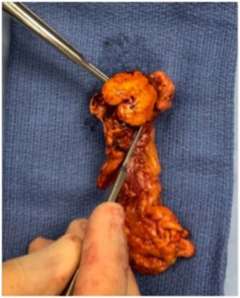Hyperaldosteronism
Find your care
We deliver effective, minimally invasive treatments in a caring environment. Call to connect with an expert in endocrine surgery.
What is Hyperaldosteronism?
Primary Aldosteronism (also known as Conn’s Syndrome)
Primary aldosteronism affects 5-15% of patients with hypertension (high blood pressure). Research has shown that primary aldosteronism is much more common than doctors once believed. It affects adults between the ages of 20 and 60, and affects women more often than men. Patients with primary aldosteronism are typically taking 3 or more blood pressure medications. They may also have low potassium levels in the blood.
When potassium levels get very low, for instance during exercise or dehydration, patients may experience muscle cramping, muscle weakness, or rarely paralysis. Primary aldosteronism can be caused by either an aldosterone-producing adenoma (a small benign tumor in one adrenal gland, usually measuring 2 cm or less) or bilateral adrenal hyperplasia (over-secretion of aldosterone from both adrenal glands equally). Aldosterone-producing adenomas are best treated with surgery (endoscopic adrenalectomy), whereas bilateral adrenal hyperplasia is best treated with medication (mineralocorticoid antagonists such as spironolactone and eplerenone).
Diagnosis
The diagnosis of primary aldosteronism rests on measuring the plasma aldosterone level and the plasma renin activity, and calculating the ratio between the two. The diagnosis can be challenging, often requiring testing on more than one occasion as well as confirmatory testing. After the diagnosis of primary aldosteronism is established, most patients undergo both CT scanning of the adrenal glands and adrenalvein sampling. Adrenal vein sampling is a procedure in which a “heat map” of aldosterone levels is produced by taking blood samples from both adrenal veins through a small puncture in the groin. This serves to confirm that more aldosterone is being produced from one side than the other. After surgery, patients with primary aldosteronism experience normal potassium levels and lowering of the blood pressure. This generally permits a reduction in the number of blood pressure medications and, rarely, complete cure of hypertension. Cure of hypertension is more common in patients who are young, female, lean, and without a family history of hypertension.
Causes, incidence, and risk factors
Primary hyperaldosteronism used to be considered a rare condition, but some experts believe that it may be the cause of high blood pressure in 0.5% to 14% of patients. Most cases of primary hyperaldosteronism result from a benign tumor of the adrenal gland, and occur in people between the ages of 30 and 50 years old.
The excess aldosterone secreted in this condition increases sodium reabsorption and potassium loss by the kidneys. The result is an electrolyte imbalance.
Secondary hyperaldosteronism is generally related to hypertension (high blood pressure). It is also related to disorders such as cardiac failure, cirrhosis of the liver, and nephrotic (kidney) syndrome. In these disorders, various mechanisms from the individual disease cause the level of the hormone to be elevated.
Symptoms
- High blood pressure
- Headache
- Muscle weakness
- Fatigue
- Intermittent paralysis
- Numbness
Signs and tests
- Low serum potassium level
- Abdominal CT scan that shows adrenal mass
- Elevated plasma aldosterone level
- Elevated urinary aldosterone
- Low plasma renin activity
- ECG that shows heart rhythm abnormalities associated with low potassium levels
This disease may also alter the results of the following tests:
- Urine sodium
- Serum sodium
- Urine potassium
- Serum magnesium test
- CO2
Treatment
Primary hyperaldosteronism resulting from an adenoma (tumor) is usually treated surgically. Removal of adrenal tumors may control the symptoms. Even after surgery, some people have elevated blood pressure and require medication.
Dietary sodium restriction and administration of medication may control the symptoms without surgery. Medications used to treat hyperaldosteronism are the diuretic ("water pill") spironolactone (Aldactone; Aldactazide) or eplerenone (Inspra), which blocks aldosterone action. In secondary hyperaldosteronism, there is no surgical intervention, but medications and diet will be included in the patient's treatment.
Expectations (prognosis):
The prognosis for primary hyperaldosteronism is good with early diagnosis and treatment. The prognosis for secondary hyperaldosteronism will vary depending on the cause of the condition.
Complications
Impotence and gynecomastia (enlarged breasts in men) may be associated with long-term treatment in men.
Calling your health care provider
Call for an appointment with your health care provider if symptoms of hyperaldosteronism develop.
Find your care
We deliver effective, minimally invasive treatments in a caring environment.
Call to connect with an expert in endocrine surgery.
